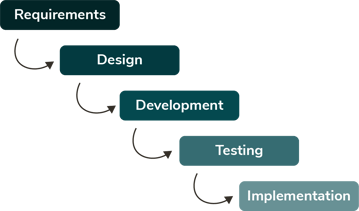Waterfall and Agile are both process methodologies with very different approaches to achieving the same goal: developing high-quality products. Where Waterfall focuses on strict requirements and planning, Agile provides a more adaptable approach where it's much easier to adjust requirements and timelines as the product develops. Both methods have their pros and cons, hopefully this article will help clear up which one is right for your project!
What is Waterfall?
Waterfall is a linear and sequential process methodology. It breaks up projects into several distinct phases, with a complete product being delivered only after the final phase is successfully finished. An example of these phases may be something like:
Requirements > Design > Development > Testing > Implementation
These phases are completed in order, where all tasks associated with that respective phase are complete before the next phase can begin. The teams required in each phase can be distinct, and may require only slight overlap between phases. Both the customer requirements and timeline are established early on within the product development life-cycle. The Waterfall methodology really excels when product requirements are strict, and the goal is to provide complete product within a specified timeframe and budget.

As someone that comes from a background developing manufacturing processes, the waterfall methodology was basically a way of life. Every new product life cycle began with Advanced Product Quality Planning (APQP) and its phases:
Planning > Product Design & Development > Process Design & Development > Product & Process Validation > Production
These processes are followed in order, with a review at the end of each phase by their respective team. In most cases, shortly after beginning production for one project, the planning phase for the next project would already have started, and so on. The strict product requirements, tight deadlines and long lead times to design and build manufacturing equipment lends itself well to waterfall. Lead times for manufacturing equipment can range anywhere from 3 months to over a year depending on complexity, so establishing clear product requirements early is imperative. Any change to the product or process requirements could result in extreme delays to the project.
Pros
- Project timelines, budget and progress are easier to manage and measure throughout distinct phases.
- More hands-off for customers after initial requirements and timelines are established.
- Detailed documentation is more readily available.
Cons
- Need strict requirements very early on, changes to these requirements can be costly.
- Less overlap and communication between teams makes collaboration more difficult.
- The testing phase occurs much later in the project, so any issues found can be expensive and delay projects drastically.
- Distinct teams, rigid timelines and budget constraints make it difficult to move back to a previous phase if issues arise.
What is Agile?
What Exactly is Agile Methodology? It's an iterative and highly adaptable process methodology. Agile focuses on breaking down projects into small product releases that can then be iterated on to make improvements. These iterations go through all phases of a project simultaneously. This allows a team member to be testing out one feature, while another is designing a different feature. With all of the phases of a project moving simultaneous, having a fully cross-functional team engaged throughout each iteration is imperative. After each iteration is complete, clients can review the most recent release and set priorities and goals for the team in the following iterations. The Agile methodology excels when requirements may need to adapt as the customer's needs develop, and there aren't strict requirements for timeframe and budget.

Software development is one of the key uses for the Agile methodology. With new product requirements frequently coming up and an on-going timeline for completion, breaking the project down into continually improving iterations is a much better way to control changes. With each new iteration, clients will find new beneficial features they'd like implemented, and these feature requests will be turned into tasks to be planned for future iterations. The average time for an iteration is usually between 1 and 4 weeks, so clients frequently get a look at the current state of the product and are able to evaluate priorities for future iterations accordingly. Agile works incredibly well when requirements are not fully established up front, which is usually the case with software development projects.
Pros
- Highly adaptable and works well when customer requirements are not completely established up front.
- Fully cross-functional teams promote higher collaboration than distinct teams.
- Frequent customer communication helps ensure requirements are being met and customer satisfaction is high.
- Testing is performed concurrently with development during each iteration, leading to faster identification and correction of issues.
Cons
- Tracking timelines, budget and project progress is more difficult across multiple iterations.
- Additional iterations can lead to lengthened timelines and increased budget.
- Documentation is usually lacking between iterations.
Related: 4 success stories of organizations that successfully implemented Agile-at-Scale
At Praecipio, we have more than 15 years of experience helping clients big and small become the best version of themselves; if you have questions on Waterfall, Agile, or any other process methodology, reach out and let us know, we'd love to help!
